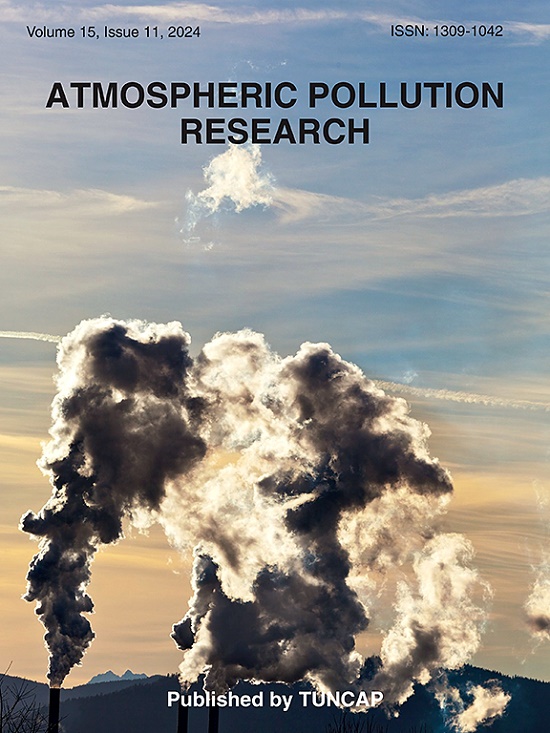Real-time analysis of NOx emissions in heavy-duty diesel vehicles: Impact of speed and variations across vehicle groups
IF 3.5
3区 环境科学与生态学
Q2 ENVIRONMENTAL SCIENCES
引用次数: 0
Abstract
This study analyzes the NOx emission factors of heavy-duty diesel vehicles monitored in the Metropolitan Region of Rio de Janeiro (MRRJ) between February 2022 and April 2024, with the aim of assessing compliance with the PROCONVE (Air Pollution Control Program for Vehicles) program. To the best of our knowledge, this study is unprecedented in the country and one of the few studies conducted in Latin America. The results showed great variability in NOx emissions, reflecting differences in emission control technologies, vehicle age, maintenance conditions, and operational characteristics. The average NOx emissions for the fourteen vehicles were 3322 ± 106 ppm, ranging from 1.51 to 1257 ppm. The analysis indicated that vehicle weight influenced emissions, with greater variability in the lightest vehicles. Engine power was another relevant factor, with intermediate-power vehicles (188 kW and 191 kW) presenting the lowest emissions, challenging the assumption that more powerful engines always generate more emissions. Regarding the age of the vehicles, the newer ones emitted less NOx than the older ones. When converting the emission factors to g kWh−1 using a theoretical conversion factor, more than 50 % of the vehicles exceeded the 2 g kWh−1 limit established by the PROCONVE P-7 standard. It should be noted that the actual load conditions of the engine are different and therefore this comparison is qualitative only. Most of the monitored vehicles operated at low speeds (up to 40 km h−1), typical of urban environments, highlighting the influence of traffic conditions on emissions. The analysis revealed different behaviors among vehicle groups: emissions increased with speed for WM vehicles, which operate between the MRRJ and the mountainous regions, while they decreased for M vehicles, which deliver dry cargo within the MRRJ, mainly in the southern zone of Rio de Janeiro. The results reinforce the need for environmental policies aimed at fleet renewal, adoption of advanced emission control technologies, and promotion of more efficient driving practices. Future studies should investigate the relationship between operating conditions, speed variability and NOx emissions in different contexts.
重型柴油车氮氧化物排放的实时分析:速度的影响和不同车辆组的变化
本研究分析了2022年2月至2024年4月期间在巴西首都地区(MRRJ)监测的重型柴油车的氮氧化物排放系数,目的是评估对PROCONVE(车辆空气污染控制计划)计划的遵守情况。据我们所知,这项研究在该国是前所未有的,也是在拉丁美洲进行的少数研究之一。结果表明,氮氧化物排放量存在较大差异,这反映了排放控制技术、车辆年龄、维护状况和运行特性的差异。14辆车的平均氮氧化物排放量为3322±106 ppm,范围从1.51到1257 ppm。分析表明,车辆重量影响排放,最轻的车辆变化更大。发动机功率是另一个相关因素,中功率汽车(188千瓦和191千瓦)的排放最低,挑战了大功率发动机排放越多的假设。就车辆的使用年限而言,新车比旧车排放的氮氧化物更少。当使用理论换算系数将排放系数转换为g kWh−1时,超过50%的车辆超过了PROCONVE P-7标准规定的2g kWh−1限制。应该注意的是,发动机的实际负载条件是不同的,因此这种比较只是定性的。大多数受监测的车辆以低速(最高40公里/小时)运行,典型的城市环境,突出了交通状况对排放的影响。分析揭示了不同车辆组之间的不同行为:在MRRJ和山区之间运行的WM车辆的排放量随着速度的增加而增加,而在MRRJ内运输干货的M车辆的排放量则减少,主要是在里约热内卢的南部地区。研究结果表明,需要制定环境政策,以更新车队,采用先进的排放控制技术,并推广更有效的驾驶方式。未来的研究应该调查不同环境下操作条件、速度变化和氮氧化物排放之间的关系。
本文章由计算机程序翻译,如有差异,请以英文原文为准。
求助全文
约1分钟内获得全文
求助全文
来源期刊

Atmospheric Pollution Research
ENVIRONMENTAL SCIENCES-
CiteScore
8.30
自引率
6.70%
发文量
256
审稿时长
36 days
期刊介绍:
Atmospheric Pollution Research (APR) is an international journal designed for the publication of articles on air pollution. Papers should present novel experimental results, theory and modeling of air pollution on local, regional, or global scales. Areas covered are research on inorganic, organic, and persistent organic air pollutants, air quality monitoring, air quality management, atmospheric dispersion and transport, air-surface (soil, water, and vegetation) exchange of pollutants, dry and wet deposition, indoor air quality, exposure assessment, health effects, satellite measurements, natural emissions, atmospheric chemistry, greenhouse gases, and effects on climate change.
 求助内容:
求助内容: 应助结果提醒方式:
应助结果提醒方式:


